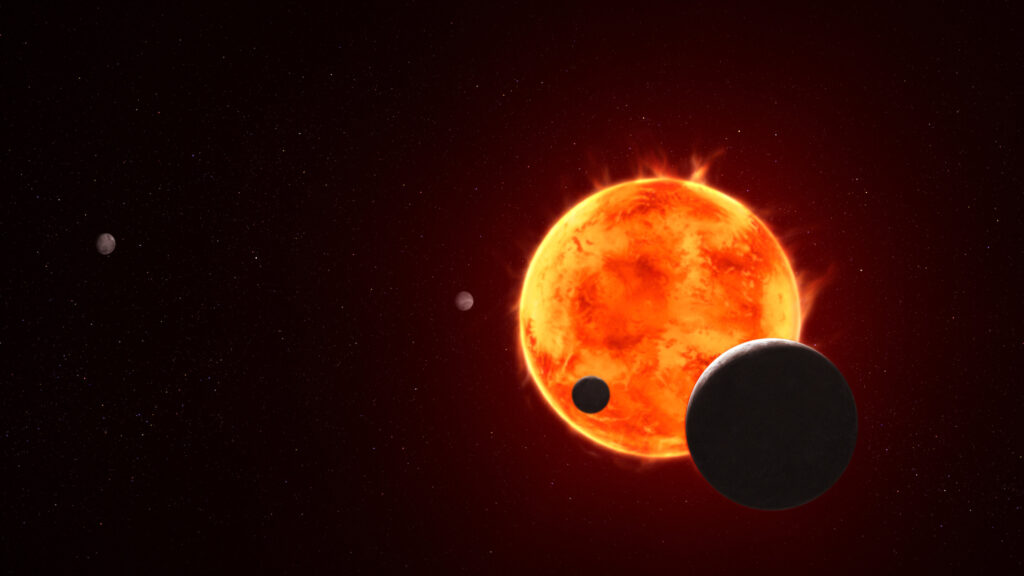
University of Bristol astrophysicists have taken a significant step forward in understanding TRAPPIST-1e, an Earth-sized exoplanet located 40 light-years away. This distant world may host liquid water in the form of a global ocean or icy expanse, but only if an atmosphere is present. The mystery of its atmosphere is now closer to being unraveled, thanks to observations made with the largest telescope in space.
Using NASA’s James Webb Space Telescope (JWST), researchers are part of an international project investigating the atmosphere and surface of TRAPPIST-1e, also known as planet e. This planet orbits within the habitable zone of the red dwarf star TRAPPIST-1. Exoplanets, which orbit stars outside our solar system, are varied and complex. Planet e is particularly intriguing because the presence of liquid water is theoretically possible, contingent upon the existence of an atmosphere.
Breakthrough Observations with JWST
The researchers directed JWST’s powerful Near-Infrared Spectrograph (NIRSpec) at the TRAPPIST-1 system as planet e transited its star. The starlight passing through the planet’s atmosphere, if present, would be partially absorbed, revealing chemical compositions through dips in the light spectrum captured by JWST. Each transit provides clearer insights into the atmospheric contents.
Initial findings, published in The Astrophysical Journal Letters, suggest several scenarios, including the potential presence of an atmosphere. Dr. Hannah Wakeford, Associate Professor in Astrophysics at the University of Bristol, played a key role in designing the observational setup to ensure the acquisition of vital data.
“What we have found with JWST in these first four observations helps refine the earlier Hubble measurements and reveals there might now be hints of an atmosphere, but we cannot yet rule out the possibility there is nothing to detect.” — Dr. Hannah Wakeford
Understanding the Atmospheric Dynamics
While various possibilities remain for planet e, researchers are confident that the planet does not retain its original atmosphere. Dr. David Grant, a former Senior Research Associate at the University of Bristol, elaborated on the findings.
“The findings also further rule out the presence of a primordial hydrogen-based atmosphere. This is the gaseous envelope, mainly comprising hydrogen, that surrounded a planet in its early stages of formation.” — Dr. David Grant
Dr. Wakeford noted that TRAPPIST-1’s active nature, with frequent stellar flares, likely stripped any hydrogen-helium atmosphere from planet e. Many planets, including Earth, form a secondary atmosphere after losing their primary one. It remains uncertain whether planet e has developed such an atmosphere.
Potential for Liquid Water
The presence of a secondary atmosphere could allow liquid water to exist on the surface. If so, it would likely be accompanied by a greenhouse effect similar to Earth’s, where gases like carbon dioxide stabilize the atmosphere and maintain warmth.
The second paper, focusing on theoretical interpretations, was led by Dr. Ana Glidden from MIT. She explained that planet e’s atmosphere is unlikely to be dominated by carbon dioxide, unlike Venus or Mars. The TRAPPIST-1 system is distinct from our solar system, with its unique star and planetary configurations.
“A little greenhouse effect can go a long way, and the new measurements do not rule out sufficient carbon dioxide to sustain some liquid water on the surface.” — Dr. Hannah Wakeford
Due to the tidal locking of TRAPPIST-1’s planets, one side of planet e always faces the star, potentially allowing a global ocean or smaller water-covered areas surrounded by ice.
Next Steps and Future Research
The next phase of research will involve further detailed observations and comparisons with another exoplanet, planet b, which orbits closest to TRAPPIST-1. Dr. Néstor Espinoza, an Associate Astronomer and Mission Scientist for Exoplanet Science at the Space Telescope Science Institute, emphasized the importance of JWST’s detailed observations.
“Webb’s infrared instruments are giving us more detail than we’ve ever had access to before, and the initial four observations we’ve been able to make of planet e are showing us what we will have to work with when the rest of the information comes in.” — Dr. Néstor Espinoza
The JWST, an international collaboration led by NASA, ESA, and CSA, continues to be the world’s premier space science observatory. It is poised to further unravel the mysteries of distant worlds and the universe’s complex structures.






